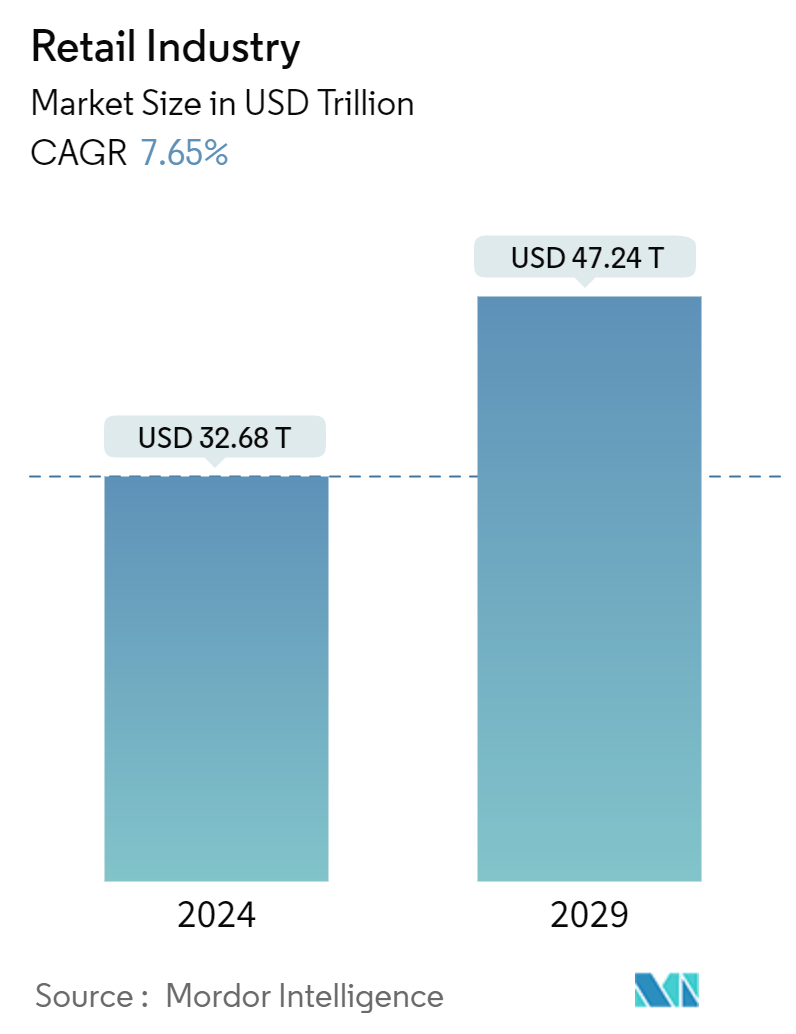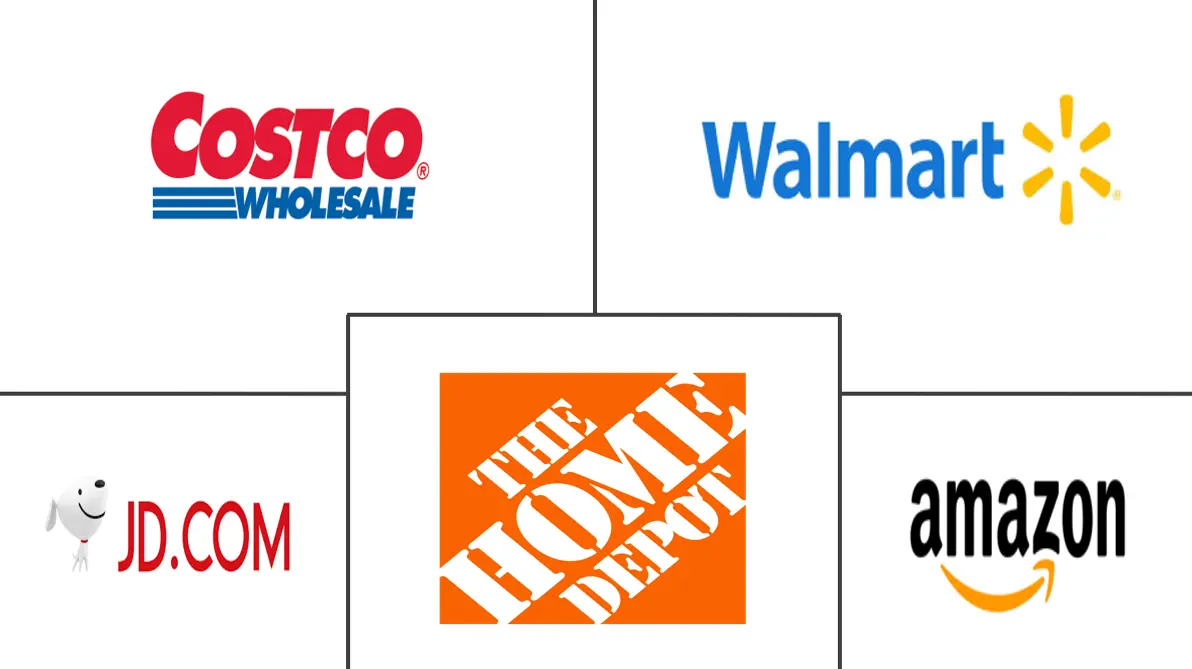Market Size of Retail Industry

| Study Period | 2020 - 2029 |
| Market Size (2024) | USD 32.68 Trillion |
| Market Size (2029) | USD 47.24 Trillion |
| CAGR (2024 - 2029) | 7.65 % |
| Fastest Growing Market | Asia Pacific |
| Largest Market | North America |
Major Players
*Disclaimer: Major Players sorted in no particular order |
Retail Market Analysis
The Retail Industry is expected to grow from USD 32.68 trillion in 2024 to USD 47.24 trillion by 2029, at a CAGR of 7.65% during the forecast period (2024-2029).
Retail is a broad and dynamic sector that includes many enterprises, from big-box retailers to conventional brick-and-mortar establishments and everything in between. The retail industry is undergoing a tremendous transition because of changing consumer tastes, technological improvements, and market trends shaping an ever-evolving landscape. E-commerce has emerged as a dominant force, fueled by the widespread adoption of digital technologies, mobile commerce, and changing shopping behaviors. Retailers increasingly leverage data analytics, artificial intelligence, and personalized marketing strategies to enhance customer experiences and drive sales.
Furthermore, the COVID-19 pandemic has expedited the transition toward multichannel retailing and online buying, forcing merchants to innovate and adjust in response to shifting customer preferences and needs. Sustainability and social responsibility have also become key considerations for retailers, with consumers increasingly seeking ethically sourced products and environmentally friendly practices. Retailers are improving their supply chain operations to improve efficiency, reduce costs, and meet increasing consumer demands for faster delivery. This includes implementing advanced inventory management systems, last-mile delivery solutions, and warehouse automation. Overall, the global retail industry remains highly competitive and dynamic, with opportunities for growth and innovation amidst evolving consumer trends and market dynamics.
Retail Industry Segmentation
The retail industry revolves around selling products and services to end users. Retailers buy goods from producers, distributors, or wholesalers and resell them directly to customers via a variety of channels. The retail industry is segmented by product type, distribution channel, and geography. By product type, the market is segmented into food, beverage, and grocery, personal and household care, apparel, footwear, and accessories, furniture and home décor, toys, hobby, and household appliances, and pharmaceuticals. By distribution channel, the market is segmented into supermarkets/hypermarkets, specialty stores, online stores, and other distribution channels (convenience stores and department stores). By geography, the market is segmented into North America, Europe, Asia-Pacific, Latin America, Middle East and Africa. The report offers market size and forecasts for the retail market in value (USD) for all the above segments.
| By Product Type | |
| Food, Beverage, and Grocery | |
| Personal and Household Care | |
| Apparel, Footwear, and Accessories | |
| Furniture and Home Decor | |
| Toys, Hobby, and Household Appliances | |
| Pharmaceuticals |
| By Distribution Channel | |
| Supermarkets/Hypermarkets | |
| Specialty Stores | |
| Online | |
| Other Distribution Channels |
| By Geography | |||||||||
| |||||||||
| |||||||||
| |||||||||
| |||||||||
|
Retail Industry Size Summary
The retail industry is experiencing significant transformation driven by evolving consumer preferences, technological advancements, and market trends. This sector encompasses a wide range of businesses, from large-scale retailers to traditional brick-and-mortar stores. The rise of e-commerce has been particularly impactful, as it reshapes how retailers interact with consumers and conduct transactions. The adoption of digital technologies and mobile commerce has made e-commerce a dominant force, offering retailers global reach, operational convenience, and cost efficiencies. Retailers are increasingly utilizing data analytics, artificial intelligence, and personalized marketing to enhance customer experiences and drive sales. The COVID-19 pandemic has further accelerated the shift towards multichannel retailing, prompting retailers to innovate and adapt to changing consumer needs. Sustainability and social responsibility are also becoming crucial, with consumers favoring ethically sourced and environmentally friendly products.
In the Asia-Pacific region, the retail market is rapidly evolving, fueled by a growing middle class, urbanization, and increased consumer spending. The region's e-commerce sector has seen explosive growth, supported by widespread smartphone adoption, improved internet connectivity, and a tech-savvy population. Major e-commerce platforms like Alibaba, JD.com, Flipkart, and Shopee are leading the charge in countries such as China, India, and Southeast Asia. Retailers in this region are adopting omnichannel strategies to provide seamless shopping experiences, integrating online and offline channels to meet consumer demands for convenience and personalization. The adoption of digital payment platforms like Alipay, WeChat Pay, Paytm, and GrabPay is further driving e-commerce growth and financial inclusion. The retail industry remains highly competitive, with key players like Walmart, Amazon, Costco, The Home Depot, and JD.com leveraging cutting-edge technologies to gain a competitive edge.
Retail Industry Market Size - Table of Contents
-
1. MARKET DYNAMICS AND INSIGHTS
-
1.1 Market Overview
-
1.2 Market Drivers
-
1.2.1 Rapid Expansion of Urban Areas
-
1.2.2 Rise of E-commerce and Omnichannel Retailing
-
-
1.3 Market Restraints
-
1.3.1 Supply Chain Complexity
-
-
1.4 Market Opportunities
-
1.4.1 Increasing Focus on Innovative Retail Services
-
1.4.2 Harnessing Data Analytics for Customer Engagement
-
-
1.5 Value Chain Analysis
-
1.6 Industry Attractiveness: Porter's Five Forces Analysis
-
1.6.1 Threat of New Entrants
-
1.6.2 Bargaining Power of Buyers
-
1.6.3 Bargaining Power of Suppliers
-
1.6.4 Threat of Substitutes
-
1.6.5 Intensity of Competitive Rivalry
-
-
1.7 Insights into Technological Advancements in the Industry
-
1.8 Impact of COVID-19 on the Market
-
-
2. MARKET SEGMENTATION
-
2.1 By Product Type
-
2.1.1 Food, Beverage, and Grocery
-
2.1.2 Personal and Household Care
-
2.1.3 Apparel, Footwear, and Accessories
-
2.1.4 Furniture and Home Decor
-
2.1.5 Toys, Hobby, and Household Appliances
-
2.1.6 Pharmaceuticals
-
-
2.2 By Distribution Channel
-
2.2.1 Supermarkets/Hypermarkets
-
2.2.2 Specialty Stores
-
2.2.3 Online
-
2.2.4 Other Distribution Channels
-
-
2.3 By Geography
-
2.3.1 North America
-
2.3.1.1 United States
-
2.3.1.2 Canada
-
2.3.1.3 Rest of North America
-
-
2.3.2 Europe
-
2.3.2.1 United Kingdom
-
2.3.2.2 Germany
-
2.3.2.3 France
-
2.3.2.4 Russia
-
2.3.2.5 Italy
-
2.3.2.6 Spain
-
2.3.2.7 Rest of Europe
-
-
2.3.3 Asia-Pacific
-
2.3.3.1 India
-
2.3.3.2 China
-
2.3.3.3 Japan
-
2.3.3.4 Australia
-
2.3.3.5 Rest of Asia-Pacific
-
-
2.3.4 South America
-
2.3.4.1 Brazil
-
2.3.4.2 Argentina
-
2.3.4.3 Rest of South America
-
-
2.3.5 Middle East and Africa
-
2.3.5.1 United Arab Emirates
-
2.3.5.2 South Africa
-
2.3.5.3 Rest of Middle East and Africa
-
-
-
Retail Industry Market Size FAQs
How big is the Retail Industry?
The Retail Industry size is expected to reach USD 32.68 trillion in 2024 and grow at a CAGR of 7.65% to reach USD 47.24 trillion by 2029.
What is the current Retail Industry size?
In 2024, the Retail Industry size is expected to reach USD 32.68 trillion.

